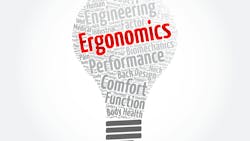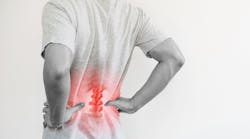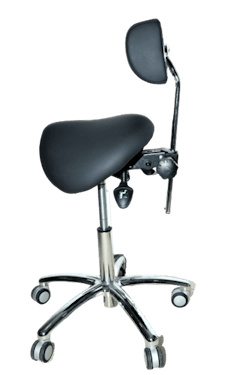The most important stool in the dental office: Your ergonomic stool
Since the Industrial Revolution, the percentage of musculoskeletal disorders (MSDs) due to sedentary work designs and sitting has increased dramatically.1 The human body is designed for frequent movement. But dentistry is a professional activity performed seated, leading to a high rate of MSDs in which the lower back, neck, and shoulders are highly affected.
The rate of back, neck, and shoulder injuries in dentistry is greater than 60%. The injuries often disable a dentist from continuously working, and sometimes they completely disable the profession.2 The back is a delicate area, and the lumbar areas of the spine have great mobility and function as a biomechanical fulcrum point for many day-to-day actions.
Given the characteristics of seated work, working distances, work with the naked eye, selection of inadequate magnification technologies, and lack of postural and positional information, dentists must unfold the body into nonneutral postures to carry out their work.
Biomechanically, the lower back, specifically the lumbar area L3, L4, and L5, are the vertebrae that function as the axial axis of movement, which in dentistry manifest as rotational movements, lateral inclination, and frontal inclination.3 This affects a person in two ways:
1. The weight of the human head ranges between 12-14 lbs. The spine supports this weight, and the postural muscles of the back and abdomen perform a compensation action for this weight when moving the body into nonneutral postures. The postural muscles overwork in this area by compensating for the weight of the head, becoming fatigued with time (duration) and frequency of awkward movements. Therefore, there’s a change in the concavity of the lumbar, called lordosis, flattening it and creating an alteration in the arrangement of the lumbar discs, which with the wear and tear of years of malposition, can lead to a herniated disc, for example.4
2. The pelvis is the foundation of the human body during seated work. Conventional operator stools, with wide and flat seats, make the pelvis rotate forward, flattening the lumbar lordosis and use excess muscle activity in that area.5 The ergonomic stool has become an essential tool in dentistry. Selecting one with appropriate characteristics can positively change comfort and decrease physical and mental fatigue. (Figure 1)
What to choose in an ergonomic seat
An appropriate ergonomic stool is essential to protect these critical areas of the human body in prolonged sitting work such as dentistry. (Figure 2) The stool must be selected for the dentist, hygienist, or assistant by taking into consideration the individual anthropometric body dimensions and personal comfort tastes. There is no all-in-one chair for everyone; the selection is entirely individual. The most essential characteristics for selection are seat, support, armrest, and cylinder.
Seat: The seat should have a inclination of 8 to 12 degrees downward to place the pelvis in an ideal physiological situation, above the level of the knees. The pelvis in this type of inclined seat rotates forward, opening the angle of the hips between 110 and 125 degrees, depending on the type of seat. In this way, it protects the lumbar lordosis while maintaining its curve.
On the contrary, the conventional seat promotes backward rotation of the pelvis, flattening the lumbar curvature, generating medium long-term problems in the lumbar discs and overworking the postural muscles of the lower back, which are classic symptoms in dental professionals.6 (Figure 3)
Backrest: The backrest must have a convex shape and the necessary dimensions to provide support in the lumbar area so that it makes a convex over concave fit (lumbar lordosis) and generates the necessary support so that the muscles do not overwork.7 (Figure 4)
Armrests: Armrests are necesssary in professions where the demand for precision is high, such as dentistry. They support the large area of shoulders, neck, and trapezoids, which are interconnected and become highly fatigued by frequent work and static postures of the arms. The arms weigh 5% of the total body weight and are added to the forces of gravity.8 (Figure 5)
Cylinder: The cylinder of the stool is essential and takes into account the height of the user/operator. A standard cylinder for a very tall operator will make them feel compressed, flattening the curvature and placing the pelvis in an uncomfortable position. Like a short operator, if they do not choose the cylinder well, they could sit without being able to rest their feet firmly on the floor, generating altered pelvis positions, affecting the lumbar curve, and generating fatigue and discomfort. Guidance from the stool sales representative is essential to acquiring the right chair.
There is no all-in-one chair for everyone. A conscious choice based on the characteristics discussed here is essential to choosing the most important chair in your office. This is where the dentist spends much of the day, and a well-chosen chair makes a big difference. The benefits for the operator regarding comfort and health are proven and well-documented, and the investment can prolong your professional career and job satisfaction.
References
1. Paffenbarger RS Jr., Blair SN, Lee I-M. A history of physical activity, cardiovascular health and longevity: the scientific contributions of Jeremy N Morris, DSc, DPH, FRCP. Int J Epidemiol. 2001;30(5):1184-1192. doi.10.1093/ije/30.5.1184
2. Ohlendorf D, Naser A, Haas Y, et al. Prevalence of musculoskeletal disorders among dentists and dental students in Germany. Int J Environ Res Public Health. 2020;17(23):8740. doi:10.3390/ijerph17238740
3. Lunde LK, Koch M, Knardahl S, Veiersted B. Associations of objectively measured sitting and standing with low-back pain intensity: a 6-month follow-up of construction and healthcare workers. Scand J Work Environ Health. 2017;43(5):269–278. doi:10.5271/sjweh.3628
4. Xin‐yi Cai, Meng-si Sun, Yun-peng Huang, et al. Biomechanical effect of L4–L5 intervertebral disc degeneration on the lower lumbar spine: a finite element study. Orthop Surg. 2020;12(3):917-930. doi:10.1111/os.12703
5. O’Sullivan PB, Dankaerts W, Burnett AF, Farrell GT, Jefford E, Naylor CS, O’Sullivan KJ. Effect of different upright sitting postures on spinal-pelvic curvature and trunk muscle activation in a pain-free population. Spine. 2006;31:E707–E712. doi:10.1097/01.brs.0000234735.98075.50
6. De Bruyne MAA, Van Renterghem B, Baird A, et al. Influence of different stool types on muscle activity and lumbar posture among dentists during a simulated dental screening task. Appl Ergons. 2016;56(9):220-226. doi:10.1016/j.apergo.2016.02.014
7. Carcone SM, Keir PJ. Effects of backrest design on biomechanics and comfort during seated work. Appl Ergon. 2007;38(6):755-764. doi:10.1016/j.apergo.2006.11.001
8. Bolderman FW, Bos-Huizer JJA, Hoozemans MJM. The effect of arm supports on muscle activity, posture, and discomfort in the neck and shoulder in microscopic dentistry: results of a pilot study. 2017;5(2):92-105. doi.10.1080/24725838.2017.1335659
Editor's note: This article appeared in the April 2024 print edition of Dental Economics magazine. Dentists in North America are eligible for a complimentary print subscription. Sign up here.
Juan Carlos Ortiz Hugues, DDS, CEAS, is a master of the Academy of Microscope Enhanced Dentistry, CEAS II, and vice president of the Academy of Microscope Enhanced Dentistry (AMED). He wrote the book Ergonomics Applied to Dental Practice. He promotes efficient and painless dentistry and provides lectures, training, and advice in advanced dental ergonomics in Latin America and the US, mainly related to ergonomics applied to dental microscopy.
About the Author

Juan Carlos Ortiz Hugues, DDS, CEAS
Juan Carlos Ortiz Hugues, DDS, CEAS, is a master of the Academy of Microscope Enhanced Dentistry (AMED), associate professional in ergonomics by BCPE, CEAS II, and president of the AMED. He wrote the book, Ergonomics Applied to Dental Practice, available from Quintessence Publishing. He provides lectures, training, and advice on advanced dental ergonomics in Latin America and the United States, mainly related to ergonomics applied to dental microscopy.







